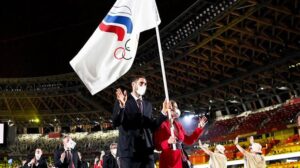At the 2020 Tokyo Olympics, there are 335 sportspersons from Russia competing with athletes from around the world. Yet, unlike their counterparts, the Russians are not allowed to use their country’s name, flag, and anthem, and are competing under the acronym ROC, which stands for Russian Olympic Committee.
In the 2020 medals tally, all of their medals are listed next to the name ROC, with a flag that is different from Russia’s official.
This is because Russia, which has historically been among the world’s top sporting nations, has been ‘banned’ from the Tokyo Olympics.
What led to Russia being ‘banned’ from Tokyo Olympics 2020?

In December 2019, the World Anti-Doping Agency (WADA) banned Russia for four years from competing in international events, including the Tokyo Olympics and the FIFA World Cup in 2022. The ban was enacted after new revelations came up about a doping programme that Russia had been accused of.
For many years, whistleblowers and investigators had accused Russia of running a doping programme so sophisticated that it forced international federations to stop its athletes from competing in major events.
In September 2018, after multiple investigations, WADA lifted the sanctions on the condition that Russia hand over athlete data from its Moscow laboratory to doping regulators, which would help identify hundreds of athletes who may have cheated across various sports.
For many years, whistleblowers and investigators had accused Russia of running a doping programme so sophisticated that it forced international federations to stop its athletes from competing in major events.
In September 2018, after multiple investigations, WADA lifted the sanctions on the condition that Russia hand over athlete data from its Moscow laboratory to doping regulators, which would help identify hundreds of athletes who may have cheated across various sports.
Russia was then accused of manipulating that database, leading to the WADA panel suggesting the four-year ban.
The case that lead to ban

2014, 800m runner Yulia Stepanova and her husband Vitaly, a former employee of the Russian Anti-Doping Agency, RUSADA, appeared in a German documentary and lifted the lid on what was later described as one of the most “sophisticated doping programmes” in sports history.
Two years later, another whistleblower — Grigory Rodchenkov, a former head of the RUSADA — told The New York Times that Russia ran a carefully planned, state-sponsored doping scheme. Rodchenkov’s claims were more damning.
He alleged a wider conspiracy, in which the country’s anti-doping and members of intelligence services substituted urine samples of the athletes through a hidden hole in the wall at the agency’s laboratory during the 2014 Sochi Winter Olympics. The lab, according to investigations, was guarded by members of Russia’s state security services.
Subsequently, the International Olympic Committee (IOC), WADA and other global federations launched a series of investigations.
What did these authorities do then?
Immediately after the allegations surfaced, the accreditation of Russia’s anti-doping lab was suspended in 2015. After the preliminary investigations, the IOC removed 111 athletes, including the entire track and field team, from Russia’s 389-member contingent for the Rio Olympics.
Following a deeper inquiry, the IOC suggested a complete ban on Russia’s participation at the 2018 Winter Olympics in Pyeongchang, South Korea.
Ultimately, 168 athletes participated through special dispensations from the international federations. But the Russian Olympic Committee was barred from attending the event and the country’s flag was not officially displayed at any of the venues. Russian athletes, too, were forced to wear neutral uniforms with “Olympic Athlete From Russia” printed on them.
MENA SUVARI SHARES ABOUT HER RAPE AND EXPLOITATION VIA PEACE OF MIND
If on the kit of any athlete the name ‘Russia’ is written, the words ‘neutral athlete’ must also be written.
COVID VACCINE DEVELOPER RECIEVED STANDING OVATION AT WIMBLEDON

